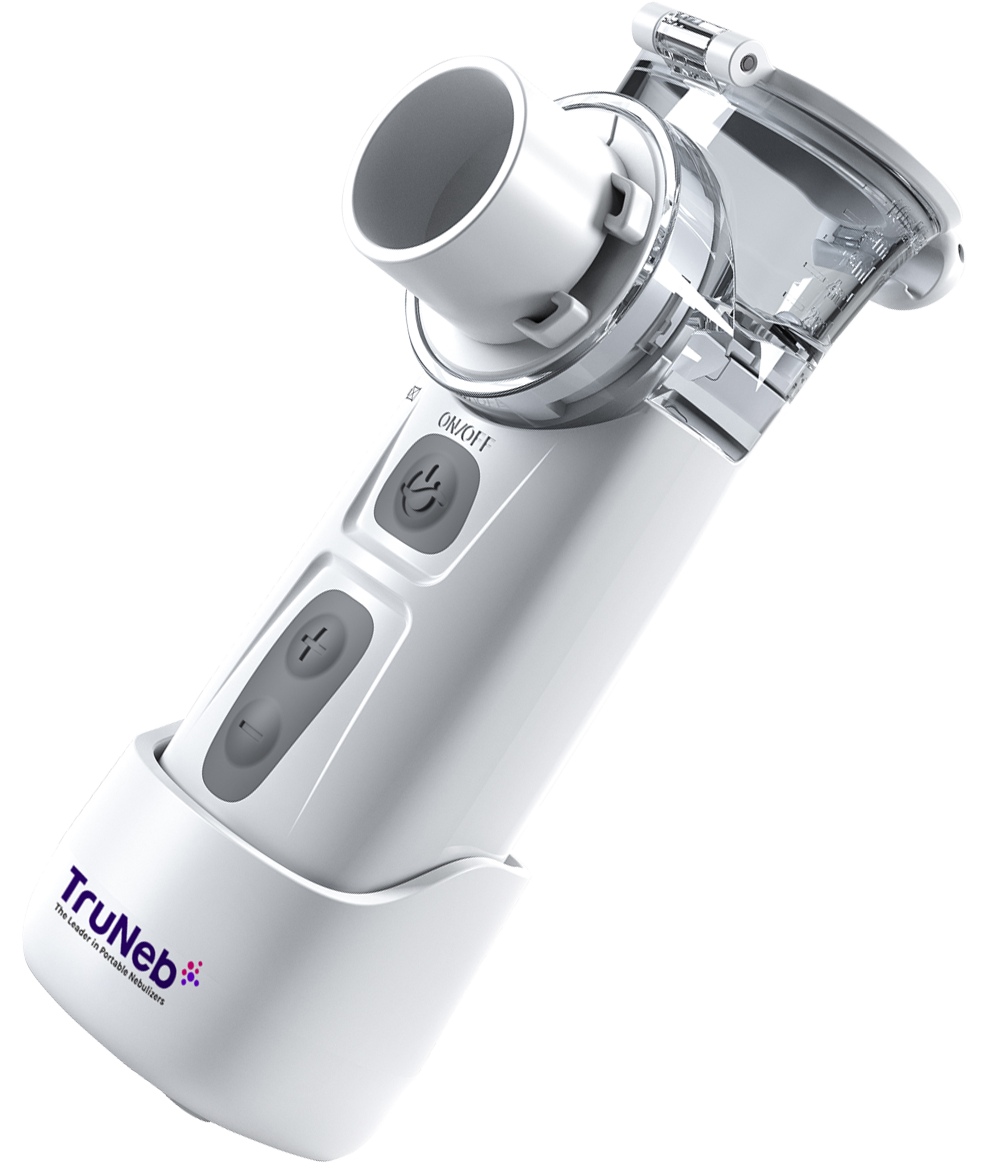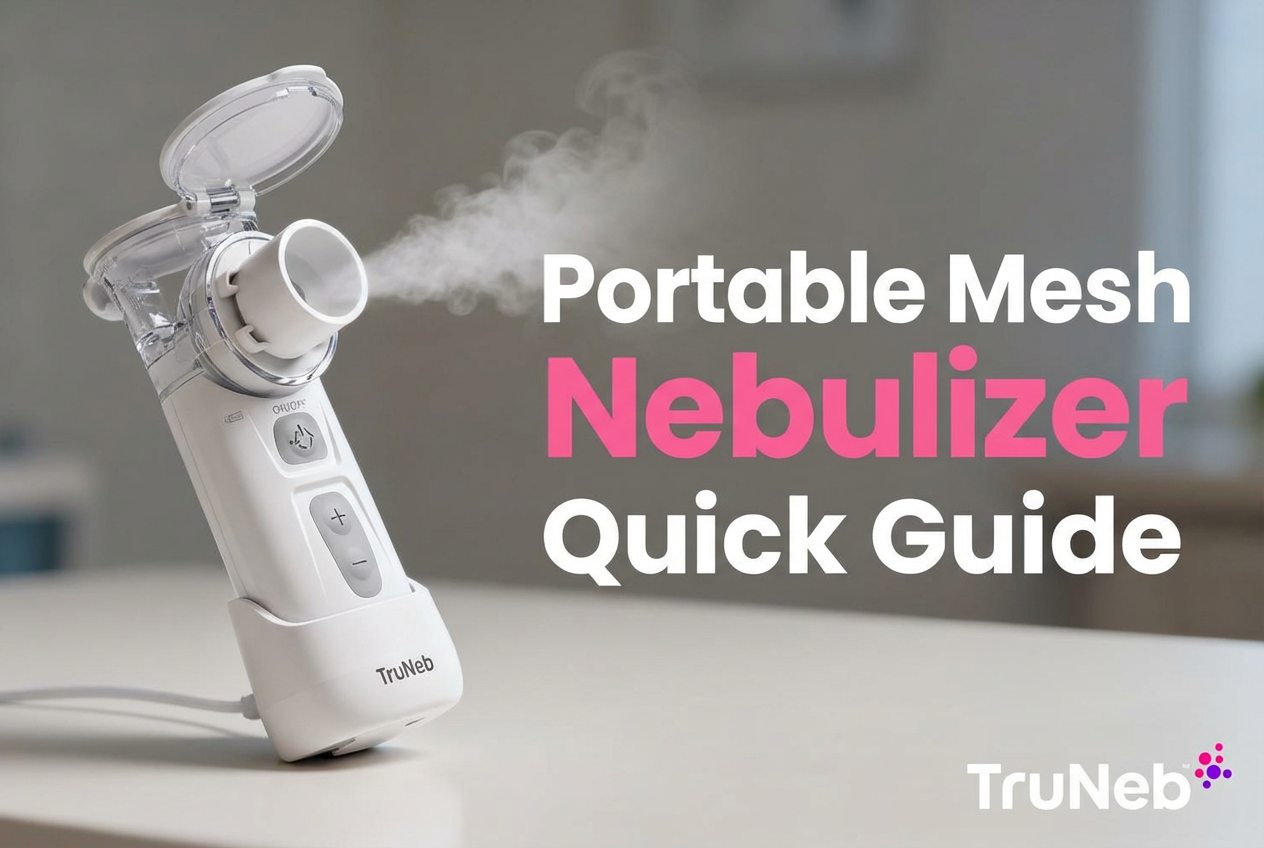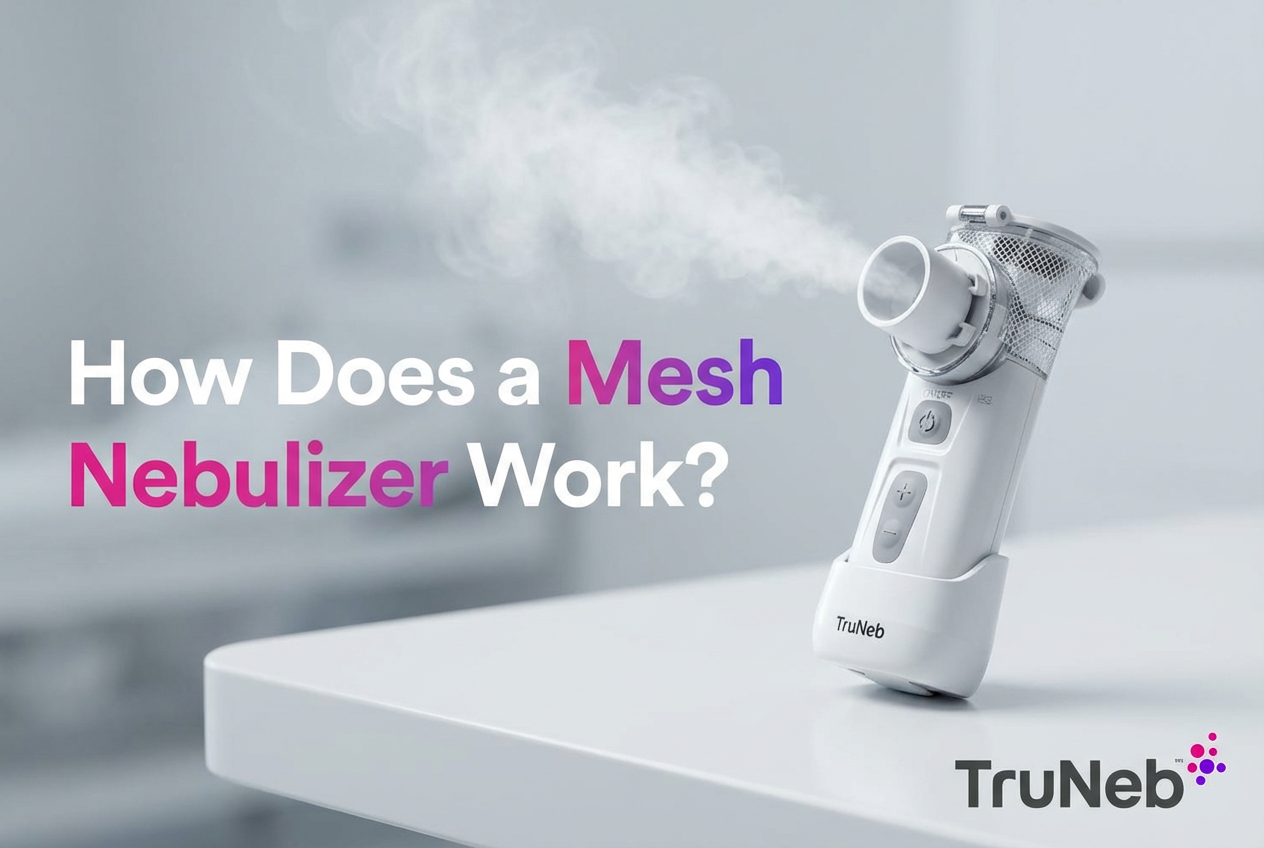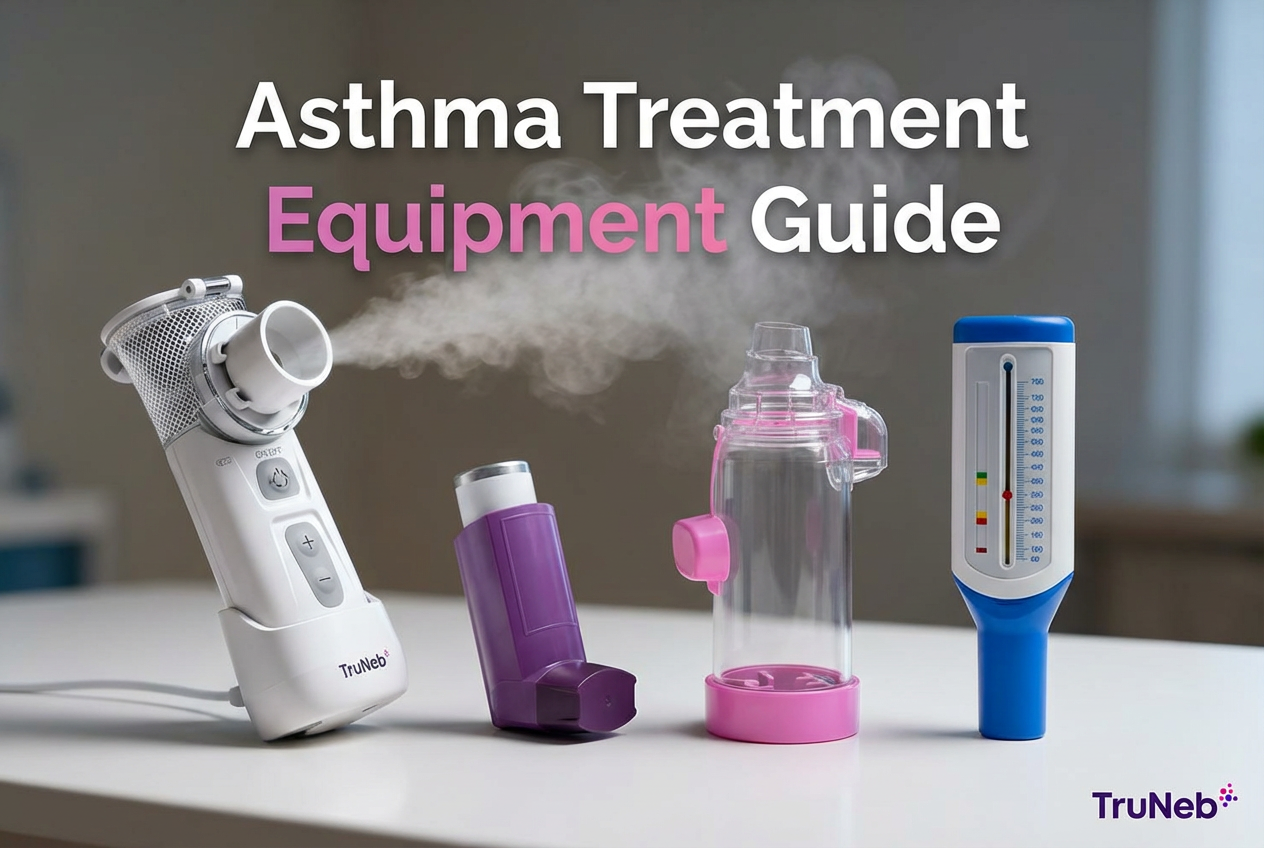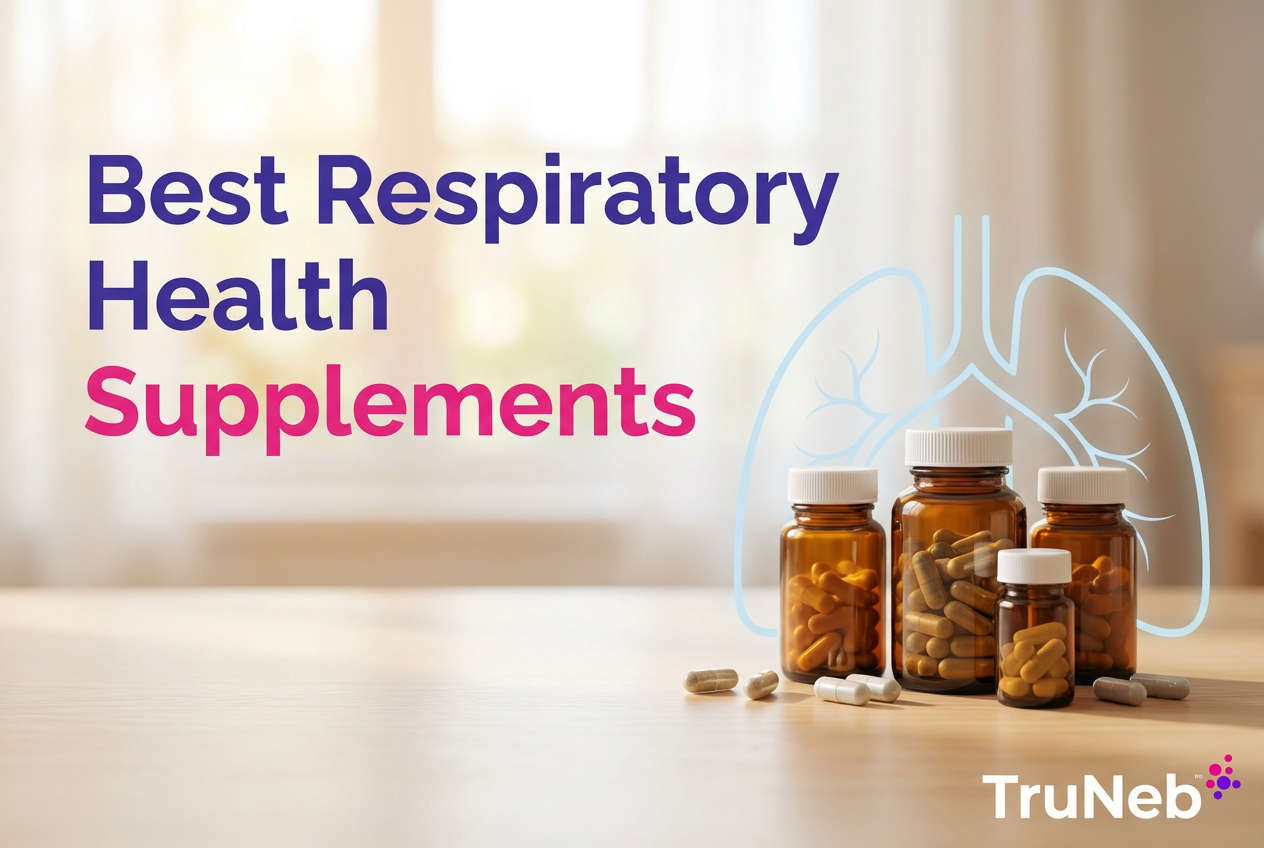On this page

A nebulizer can help relieve congestion by sending a fine mist of saline or medication into your airways. That mist moistens thick mucus so it’s easier to move. You can target chest congestion with a mouthpiece, and nasal or sinus congestion with a face mask.
Below, we cover how nebulizers loosen mucus, what to put in the cup, when they help most, step-by-step use and cleaning, how they compare with a humidifier or steam, and why a portable mesh device like the TruNeb™ Portable Mesh Nebulizer fits busy life.
A nebulizer delivers moisture and medicine directly to your airways, which can help thin and clear mucus.
If you're looking for a nebulizer for congestion relief, you can purchase the TruNeb™ Portable Nebulizer directly from our website —CLICK HERE

How Nebulizers Help with Congestion
A nebulizer turns liquid into a breathable mist that can reach deep into your lungs. For nasal relief, use a face mask so mist also enters the nose.
How it helps:
- The cool mist adds moisture that can thin sticky mucus.
- If prescribed, medicines like bronchodilators can open airways so mucus can move.
- Saline alone can soothe irritated airways and help phlegm clear.
Unlike steam, a nebulizer uses a controlled, cool mist and can carry sterile saline or prescription medications. People notice easier breathing and a more productive cough during or after a session.
Nebulizers turn liquid into a fine mist that hydrates your airways and can help thin and clear mucus.
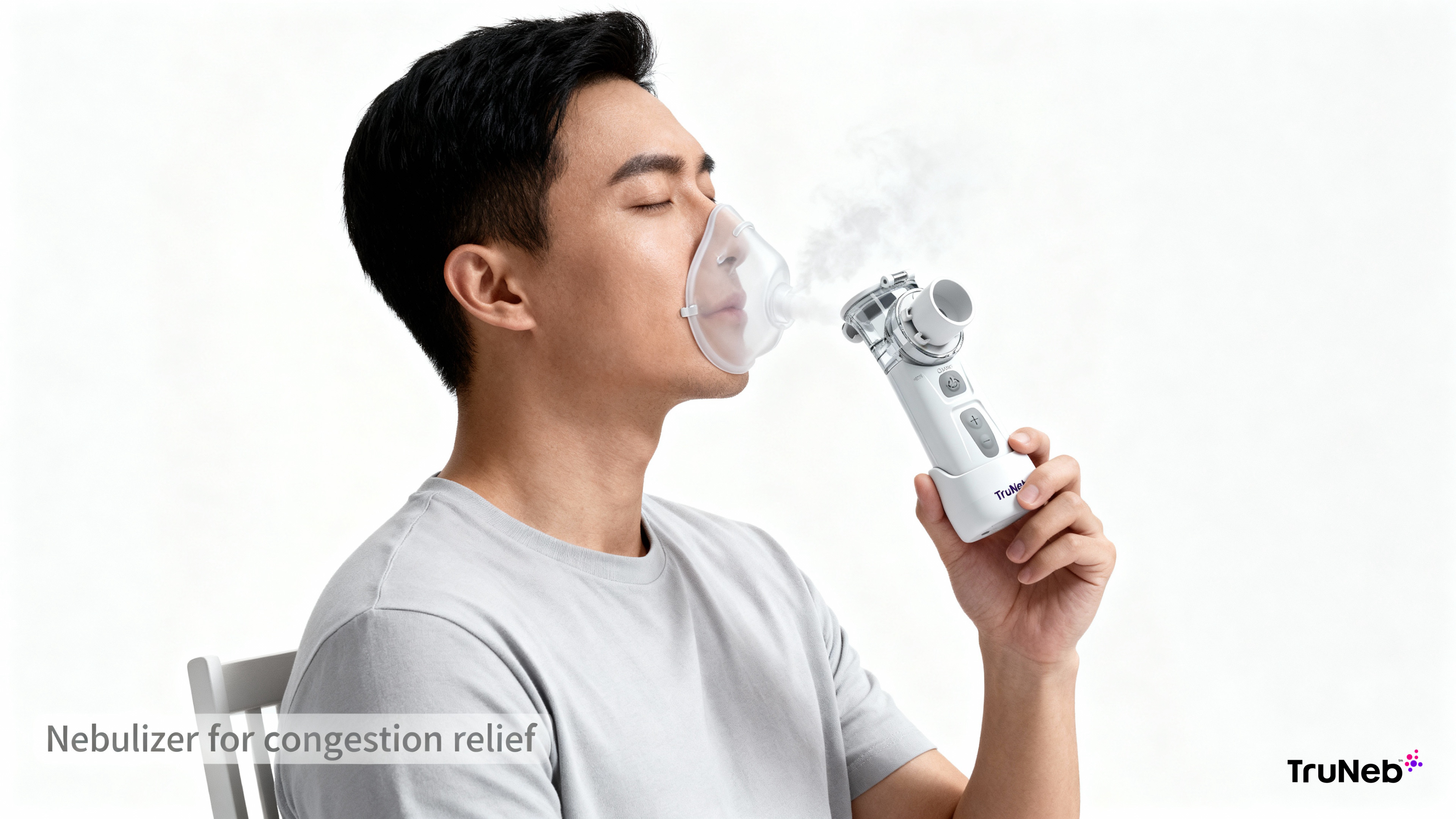
When to Use a Nebulizer for Congestion
Use a nebulizer when congestion is heavy, breathing feels tight, or mucus won’t move with simple home care.
Common times it helps:
- Chest colds or bronchitis: Wet, rattly cough with phlegm that’s hard to clear.
- Asthma or COPD with mucus: Wheeze plus thick secretions; a bronchodilator nebulizer can open airways so mucus can move.
- Sinus or nasal congestion: A saline nebulizer via face mask can moisten swollen passages so it’s easier to blow your nose.
- Infants and kids with colds: Gentle saline mist can help them breathe easier without medication.
If symptoms are mild, a humidifier or saline spray can be enough. If you have fever, chest pain, fast breathing, or symptoms not improving after a few days, see a doctor. If symptoms rapidly worsen or breathing is severe, seek emergency care.
For babies and young children, use saline only unless a doctor prescribes medication.
Reach for a nebulizer when mucus is stuck and breathing feels harder than usual.
Nebulizers for Chest Congestion
Chest congestion means mucus builds up in your airways. You can hear rattling, feel heavy in the chest, and have a wet, stubborn cough. If you’re looking for a nebulizer for cough with phlegm, this is the area it can help most.
How a nebulizer can help:
- Saline mist: Adds moisture to thick mucus so it thins and moves more easily.
- Bronchodilators (if prescribed): Open tight airways, which can make coughs more effective at clearing phlegm.
- Routine support: During chest colds, bronchitis, COPD flares, or recovery periods, short sessions can help you breathe easier.
What to expect: During or after a treatment, coughs can become more productive. Keep tissues nearby and sip water. If your doctor has given specific timing (for example, bronchodilator first, then saline), follow their plan.
Moisture plus, when prescribed, airway-opening medication can help clear lung mucus.
Common Nebulizer Solutions for Chest Symptoms
These are common options if you’re using a nebulizer for cough with phlegm:
- Albuterol or Levalbuterol (prescription): Bronchodilators that relax airway muscles to ease wheeze and help mucus move. These are a common nebulizer medicine for cough when tightness is present—ask your doctor what’s right for you.
- Ipratropium (prescription): Can reduce airway secretions and open bronchi; sometimes paired with albuterol.
- Budesonide (prescription): An inhaled steroid used for airway swelling in ongoing plans; not an immediate mucus thinner.
- Normal saline 0.9% (OTC): Sterile saltwater that moisturizes and helps thin mucus.
- Hypertonic saline 3% or 7% (available OTC from some retailers): Stronger saltwater that pulls water into mucus. Some people notice a cough reflex as mucus loosens.
Safety note: Only nebulize solutions made for inhalation. Talk to your doctor before trying a new medication.
For simple congestion, saline usually helps; for wheeze or tightness, your doctor might recommend a bronchodilator.
Nebulizers for Nasal and Sinus Congestion
Can a nebulizer help a stuffy nose? Yes. Using a face mask, breathe normally so the saline mist reaches your nose as well as your mouth. A nebulizer for nasal congestion or a nebulizer for sinus congestion uses gentle mist to moisten swollen tissues and loosen thick snot so it’s easier to blow out. A mesh nebulizer for sinus with a face mask can distribute fine particles through the nose.
What it does (and doesn’t) do:
- Moisturizes and loosens: Saline mist can soften dried mucus and soothe irritation.
- Not a flush: It won’t flush your nose like a neti pot. It gently hydrates over a few minutes.
- Good for little ones: For infants and toddlers who can’t use sprays or rinses well, a saline nebulizer session can be a gentle option.
Tip: After a nasal-focused session, gently blow your nose (or use a bulb syringe for babies) to clear loosened mucus. You can use sterile saline in nebulizer for stuffy nose, not medications, unless a doctor advises otherwise.
With a face mask, nebulized saline can soothe a stuffy nose and help mucus move.
What to Put in a Nebulizer for Congestion
- Sterile normal saline 0.9% (OTC): Great first choice for most congestion. It hydrates and helps thin mucus.
- Hypertonic saline 3% or 7% (available OTC from some retailers): Stronger option for stubborn mucus. It can cause brief coughing as secretions loosen.
- Prescription meds (if given by your doctor): Bronchodilators or other inhaled medicines for wheeze or airway swelling.
- Avoid: Plain water, essential oils, homemade mixes, or anything not labeled for nebulizers.
Only use sterile solutions labeled for nebulizers. Plain water isn’t isotonic and can irritate airways—don’t use it. Yes, you can use a nebulizer without medication by filling the cup with sterile saline.
Stick to sterile saline or prescribed meds—nothing else belongs in your nebulizer.
How to Use a Nebulizer for Congestion
- Wash your hands and set the device on a stable surface.
- Fill the cup with your solution. Use the amount on the vial or package. Close it tightly.
- Attach the mouthpiece or face mask and connect tubing if your device uses it.
- Sit upright. Mouthpiece for chest therapy; face mask if also targeting the nose.
- Turn it on. Breathe slowly and normally. Take a deeper breath every few breaths for chest therapy; inhale gently through your nose at times if using a mask.
- Continue until the mist stops (about 5–15 minutes).
- After: cough to clear loosened mucus or blow your nose.
Slow, steady breaths until the cup is empty give the mist time to work.
Cleaning and Maintenance
- After each use: Rinse the cup and mouthpiece/mask with warm water, then air-dry.
- Daily: Wash with mild dish soap, rinse well, air-dry fully.
- Weekly: Disinfect per your manual (many use a diluted white vinegar soak), then rinse and dry.
- Don’t wash the compressor tubing; replace filters as directed.
- Store parts dry in a clean container.
Clean, dry parts help prevent germs and keep your mist smooth.
Nebulizer vs Other Congestion Remedies
| Method | Target area | What it delivers | Best for | Limitations |
|---|---|---|---|---|
| Nebulizer | Lungs; nose with a mask | Sterile saline and/or prescription meds | Thick chest mucus; wheeze with mucus; nasal moisture with a mask | Needs device and cleaning; follow prescriptions for meds |
| Humidifier | Whole room (nose/throat comfort) | Water vapor | Overnight dryness; mild stuffy nose | Not targeted; no meds; mold risk if dirty[1] |
| Steam (shower/bowl) | Nose and throat | Warm steam | Quick nasal relief | Burn risk[2]; limited reach to lower lungs |
| Saline spray / neti pot | Nose & sinuses | Saline rinse | Stuffy nose; sinus pressure | No lung effect; some can’t tolerate rinses |
| Inhaler (MDI) | Lungs | Metered medication puffs | Asthma/COPD bronchospasm | No added moisture; doesn’t thin mucus |
Notes: [1] Clean per manual; never add medications or oils. [2] Use caution with hot water; keep away from children.
Use a humidifier for all-night comfort. Use a nebulizer for targeted relief when mucus is really stuck. Inhalers deliver quick bronchodilator medication but don’t add moisture or thin mucus; a nebulizer can do both by delivering medicine and saline mist.
You might see boxes labeled “steam inhaler” — these are not nebulizers and are not for breathing prescription medications.
Why a Portable Mesh Nebulizer Helps
Portable mesh nebulizers are small, quiet, and battery-powered. They make quick treatments possible at home, in the car, or on a trip. The TruNeb™ Portable Mesh Nebulizer is a small, quiet handheld device for quick treatments at home or on the go.
Benefits you’ll notice:
- Quiet and fast: Easy to use without a loud compressor.
- Travel friendly: Palm-sized and simple to pack.
- Effective mist: Fine particles help solutions reach where they’re needed.
If congestion flares at night or away from home, a portable nebulizer for congestion can be convenient to keep up with treatments.
A handheld mesh nebulizer makes on-the-go congestion relief simple.
Safety and When to Seek Care
- Only use solutions made for nebulizers.
- Keep parts clean and fully dry.
- Stop and get help if you feel worse during a treatment (dizzy, chest pain, fast heartbeat with meds).
- Talk to your doctor before trying a new medication.
- ⚠️ Seek emergency care if you have severe shortness of breath, chest pain, bluish lips or face, confusion, or symptoms that rapidly worsen.
- Talk to your doctor if symptoms don’t improve in a few days, if you have a high fever, or if you’re considering medication changes.
Use only nebulizer-safe solutions, keep parts clean and dry, and get medical help if symptoms worsen.
Frequently Asked Questions
Tap or click a question below to see the answer:
Yes. Saline treatments can loosen chest phlegm or soothe a stuffy nose. They won’t cure a virus but can help you breathe easier and sleep better.
People sometimes use saline several times a day when they’re congested. If irritation happens, pause and check with your doctor.
They do different jobs. A humidifier adds background moisture; a nebulizer gives targeted saline mist in minutes. You can use both.
Bronchodilators like albuterol or levalbuterol are commonly used to relax tight airways. Ask your doctor if medication is right for your cough.
No. Only use sterile saline or prescribed solutions made for nebulizers.
Devices and saline are usually OTC. Prescription is needed for medications like albuterol.
Key Takeaways
- Nebulizers send a fine mist of saline or meds into your airways to help thin and move mucus.
- For chest congestion, saline (and prescribed bronchodilators if needed) can make coughs more productive.
- For stuffy noses, a face mask lets saline mist soothe nasal passages so you can clear them.
- Use only proper solutions and keep your device clean.
- A portable mesh nebulizer like TruNeb fits relief into real life.
Disclaimer: This article is for informational purposes and isn’t a substitute for professional medical advice. Always talk with your doctor about your symptoms and treatments.

